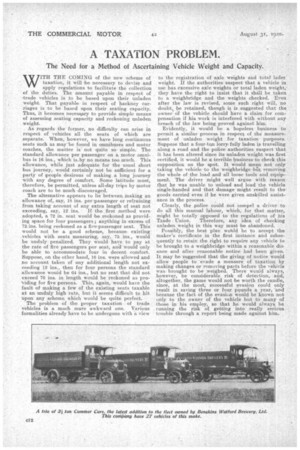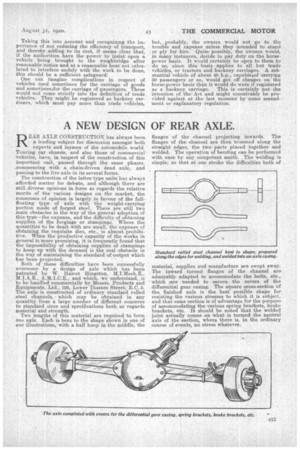A TAXATION PROBLEM.
Page 14

Page 15

If you've noticed an error in this article please click here to report it so we can fix it.
The Need for a Method of Ascertaining Vehicle Weight and Capacity.
WITH THE COMING of the new scheme of taxation, it will be necessiary to devise and apply regulations to facilitate the collection
of the duties. The amount payable in respect of trade vehicles is to be based upon their unladen weight. That payable in respect of hackney carriages is to be based upon their seating capacity. Thus, it becomes necessiu to provide simple means of assessing seating capacity and reckoniNs unladen. weight. .
As regards the former, no difficulty can arise in respect of vehicles all the seats of which are separate. When, however, we have long continuous seats such as may he found in omnibuses and motor . coaches, the matter is not quite so • simple. The standard allowance per passenger on a motor omnibus is 16 ins., which is.by no means too much. This allowance, while just adequate for the usual short bus journey, would certainly not be sufficient for a party of people desirous of making a long journey with_ any degree of comfort. Some latitude must, therefore, be permitted, unless all-day trips by motor coach are to be much discouraged.
The alternative appears to lie between Making an allowance of, .say, 18 ins. penpassenger or refraining from taking account of any extra length of seat not exceeding, say, 12 ins. If the first method were adopted, a 72 in. seat would be reckoned as providing space for four passengers ; anything in excess of 72. ins, being reckoned as a:five-passenger seat. This would not be a good scheme, because existing vehicles with seats measuring, say, 75 ins., would . be unduly penalized. They would have to pay at the rate of five passengers per seat, and would only be able to accommodate. four in decent comfort. Suppose, on the other hand, 16 ins, were allowed and no account taken of any additional length not exceeding 12 ins., then for four persons the standard allowance would be 64 ins., but no seat that did not exceed 76. ins. in 'length would be reckoned as proViding for five persons. This, again, would have the fault of making a few of the existing seats taxable at an unduly high rate, but it seems difficult to hit upon any scheme which would be quite perfect.
The problem of the proper taxation of trade vehicles is a much mere awkward one. Various formalities already have to be undergone with a view
to the registration of axle weights and totallader weight. If the authorities suspect that a vehicle in use has excessive axle weights or total laden weight,they have the right to insist that it shill. be taken to a weighbridge and the weights checked. Eyen after the law is revised, some such right will, no doubt,, ,be retained, though it is suggested that the owner of the vehicle should have a claim for 'compensation if his work is interfered with without any breach of the law being proved against him.
Evidently, it would be a hopeless business to permit .a similar process in respect of the measure
ment of unladen weight for taxation purposes.
Suppose that a four-ton lorry, fully laden is travelling along a road and the police authorities suspect. that it has been altered since its unladen weight was first certified, it would be a terrible business to check this supposition on the spot. It would mean not only taking the vehicle 'to the weighbridge but removing the whole of the load and all loose tools and equipment. The driver might well argue with reason that he was' unable to unload and load the vehicle single-handed and that damage might result to the goods •carried even if he were given .unskilled assistance in the process.
Clearly, the police could not compel a driver to do all this manual labour, which, for that matter, might be totally opposed to the regulations of his Trade Union. Therefore, any, idea of checking unladen weight in this way must be abandoned.
Possibly, the best plan woldd be to accept the maker's certificate in the first instance and subse quently to retain the right to require any vehicle to be brought to a weighbridge within a reaSonable disance and after reasonable notice had been given. It may be suggested that the giving of notice would allow people to evade a measure of taxation by making changes or removing parts before the vehicle was brought tobe weighed. There would always, however, be considerable risk of detection, and altogether, the game would not be worth the candle, since, at the most, successful evasion could only result in saving three or four pounds a year, 'and because the fact of the evasim would be known not only to the owner of the vehicle but to many of those in his employ, so that he would always. be running the risk of getting into really serious trouble through a report being made against him.. Taking this into account and recognizing the importance of not reducing the efficiency of transport, and thereby adding to its cost, it seems clear that, if the authorities have the power to insist upon a vehicle being brought to the weighbridge after reasonable notice and at a rea,sonable hour not calculated to interfere unduly with the work to be done, this should be a sufficient safeguard.
One can imagine complications in respect of vehicles used sometimes for the carriage of goods and sometimesofor the carriage of passengers. 'nese would not come strictly into the definition of trade vehicles. They might be registered as hackney carriages, which must pay more than trade vehicles,
but, probably, the owners would not go to the trouble and expense unless, they intended to ,stand or ply for hire. . Quite possibly, the owners would, in many instances, decide to pay duty on the horsepower basis. It would certainly be open to them to do so, since this basis applies to all but trade vehieles, or tractors and hackney carriages. A substantial vehicle of about 40 h.p., capableoof carrying 30 passengers or so, would get off cheaper on the horse-power basis than it would do were it registered
as a hackney, carriage. This is certainly not the intention of the Act and might conceivably be provided against at the last moment by some amendment or explanatory regulation.




























